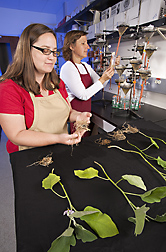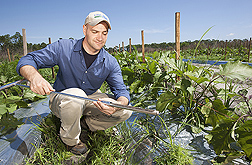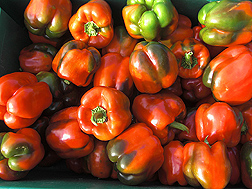Investigating Two Pathways to Replacing Methyl Bromide
|
|
As they search for soil treatments to replace methyl bromide, Agricultural Research Service scientists in Fort Pierce, Florida, are using one technique that sounds as if it were borrowed from a family recipe —taking molasses and heating it up.
Farmers have been using methyl bromide since the 1930s, but these days it is subject to strict environmental controls because it depletes Earth’s ozone layer. As part of an international agreement, growers worldwide are being required to find a replacement, a tall order because methyl bromide eliminates a broad spectrum of pests, including weeds, nematodes, and plant pathogens. The mandate is particularly challenging in Florida, where sandy soils limit organic alternatives and the mild winters serve as a safe harbor for many of nature’s most pernicious pests. Nutsedge is a particular weed problem in Florida and is a major reason methyl bromide is still used there.
“We don’t usually see the cold winter temperatures that you have in other places, so pests aren’t killed off here by Mother Nature the way they might be elsewhere,” says Erin Rosskopf, a microbiologist at the U.S. Horticultural Research Laboratory in Fort Pierce.
For Florida growers, the stakes are enormous. Fresh-market tomatoes and bell peppers, both raised in Florida with methyl bromide, netted growers there a combined $889 million in 2008. Caladiums, an ornamental also produced largely with methyl bromide, are a $15 million crop in Florida.
In their search for alternatives, ARS researchers are studying two approaches: a biologically based cropping system that builds on success overseas, and two recently developed fumigants. Similar approaches have had some success elsewhere, but the question is whether they will be effective in Florida, with its unique soils, climate, and pest pressures. Preliminary results are promising, but the researchers still need to evaluate whether the biologically based treatments can sufficiently control nutsedge.
|
|
A Biological Alternative
At the Fort Pierce lab, Rosskopf, ecologist Nancy Kokalis-Burelle, and soil scientist David Butler are raising bell peppers followed by eggplant in a field to test a biological approach that uses a combination of composted broiler litter, molasses, and anaerobic soil disinfestation (ASD). Lab colleagues Gregory T. McCollum and Joseph Albano are evaluating fruit quality and soil nutrients.
In ASD, a carbon source—in this case molasses—is added to stimulate microbial activity, and the soil is covered with a clear plastic tarp. The topsoil is saturated with water and allowed to heat. The sun-drenched tarp “cooks” the weed seeds in the soil, and the carbon and water increase microbial activity and create anaerobic conditions conducive to pest control.
In this study, before heating the soil, the researchers treated plots with different levels of organic amendments: with and without poultry litter; with and without molasses; and with 2 inches of water per acre, 4 inches per acre, or no water at all. The poultry litter increased soil moisture and added organic matter, and the molasses provided a readily available carbon source for soil microbes. The molasses they used is a waste product of the sugarcane processing industry. The researchers are also conducting studies to evaluate mustard meal, sorghum, and cowpeas as possible alternatives to molasses.
|
|
They planted peppers in the fall and eggplant in the spring for 2 years, using the type of raised-bed production system common in Florida. Before planting, the researchers introduced Phytophthora capsici to the fields, an oomycete that causes crown rot and root rot, so they could track control rates. They buried packets of it 6 inches deep in the soil and retrieved them after 3 weeks of ASD to evaluate the effects. They also sampled the soil for nematodes, counted the number of nematodes extracted from crop roots, assessed weed populations and soil properties throughout the trials, and measured crop yields.
They found that at depths of 6 inches, the ASD treatments heated the soil temperature to about 113˚F, which was at or just below lethal levels for many soil pathogens. They also found that nematode populations were reduced when treated with molasses and poultry litter, that molasses and poultry litter controlled grass weeds just as well as methyl bromide did, and that the ASD treatments controlled P. capsici in the buried packets as well as methyl bromide did, regardless of how much water, poultry litter, or molasses was applied.
“The nutsedge pressure at the test location wasn’t really adequate to show treatment differences, so we are still investigating that component,” Rosskopf says.
Evaluating New Commercial Products
Rosskopf and Kokalis-Burelle completed large-scale demonstration field trials comparing the effectiveness of two recently developed fumigants with methyl bromide at two Florida sites, one where they are raising delphiniums and the other caladiums. Both dimethyl disulfide, approved for experimental use under the trade name “Paladin,” and methyl iodide, being marketed as “Midas,” have shown promise at controlling weeds, nematodes, and plant diseases.
The researchers combined each treatment with chloropicrin, a pesticide that kills fungi and is often used in combination with methyl bromide. They applied each treatment to about a half-acre of delphiniums in a field in Hobe Sound and 2 acres of caladiums at another site in Zolfo Springs. They raised two varieties of delphiniums and four varieties of caladiums.
In the caladium trials, where the pest pressure was much higher than in the delphinium trial location, their grower cooperator also applied a soil treatment often used on caladiums known as “Telone II” (1,3-dichloropropene). They measured weed density, weeding time required, and nematode and fungal populations in the soil. They also examined roots for disease and compared the sizes and numbers of flowers produced under each treatment.
Preliminary results show the alternative fumigants were just as effective as methyl bromide at suppressing grass weeds and at controlling nematodes, but that the effectiveness of Paladin was reduced when it was used year after year.
In the delphinium trial, there were no significant differences in weed density and total weeding time or in total flower yields. In the caladium trial, they found no significant differences among methyl bromide, Paladin, and Midas in terms of total weeds, “rogue” or off-variety plants produced, or in total hours of labor for weeding, but yields were dependent on the combination of fumigant and cultivar.
“This interaction indicates that growers will have harder decisions to make, because their choice of cultivar is often market-driven. They may have to choose a fumigant that provides the greatest return for that specific cultivar, making it much more difficult than when they could use methyl bromide with everything they grew,” said Rosskopf.
The fumigant field trials are attracting widespread interest. A recent field day organized to explain the project at Zolfo Springs attracted dozens of cut-flower and caladium growers.—By Dennis O'Brien, Agricultural Research Service Information Staff.
This research is part of Methyl Bromide Alternatives (#308), an ARS national program described at www.nps.ars.usda.gov.
To reach scientists mentioned in this article, contact Dennis O’Brien, USDA-ARS Information Staff, 5601 Sunnyside Ave., Beltsville, MD 20705-5129; (301) 504-1624.
"Investigating Two Pathways to Replacing Methyl Bromide" was published in the March 2011 issue of Agricultural Research magazine.









